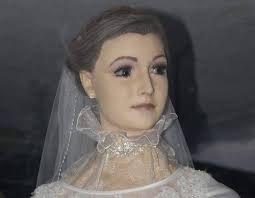S
At the heart of a small bridal shop in Chihuahua, Mexico, stands an unusual mannequin that has captured imaginations for nearly a century. Known as “Pascualita,” this life-like figure has sparked rumors and myths since it first appeared in the store’s window. But the eerie Pascualita photos that circulate online have only added to the enigma. Are these photos just images of an expertly crafted mannequin, or is there more to the story?
In this blog post, we will explore the history, legends, and mystery behind Pascualita. We will also take a closer look at the photos of Pascualita that have intrigued people worldwide, diving into why this mannequin has become such a cultural icon.
The History of Pascualita
Pascualita, also known as “La Pascualita,” made her first appearance in the window of La Popular bridal shop on March 25, 1930. The owner of the shop, Pascuala Esparza, unveiled this strikingly realistic mannequin dressed in a bridal gown. Almost immediately, customers and passersby were captivated by how lifelike Pascualita appeared.
Rumors quickly spread that Pascualita wasn’t just an ordinary mannequin. Some believed she was the embalmed body of Pascuala Esparza’s own daughter, who had tragically passed away just before her wedding day. Although there is no official confirmation of this tale, the Pascualita photos only fueled the eerie fascination surrounding this mannequin.
Pascualita’s lifelike appearance has led to many speculations, with some insisting that the mannequin’s eyes seem to follow you around the room or that her skin appears almost human-like in texture. These detailed Pascualita photos show the mannequin’s delicate hands, fingernails, and lifelike facial features, leaving many to wonder whether there is more to Pascualita than meets the eye.
Pascualita Photos: Analyzing the Visual Evidence
When you take a look at Pascualita photos, it’s easy to see why the mannequin has become such a sensation. Her face, hands, and even her veins are crafted with such incredible detail that it almost looks as though she is a real person. The photos highlight these striking features, giving rise to various theories about whether Pascualita could actually be a preserved human body.
In some Pascualita photos, you can see close-ups of her hands, which appear aged and have a lifelike texture. Some visitors have reported that her hands even seem to show signs of decay, adding to the creepy speculation. Her fingernails, unlike those of most mannequins, look natural, almost as if they are growing. Pascualita photos taken over the years reveal slight changes in her appearance, which only deepens the mystery.
The detail in these photos is particularly interesting because, unlike most mannequins, Pascualita’s body has wrinkles, veins, and imperfections that are usually seen on human skin. When looking at Pascualita photos, many people wonder whether it is even possible for a mannequin to be made with such intricate detail, especially considering she was created in the 1930s.
Myths and Legends Surrounding Pascualita
The most popular legend surrounding Pascualita is that she is the embalmed body of Pascuala Esparza’s daughter. According to this story, Pascuala was devastated after her daughter died just before her wedding and couldn’t bear to part with her. Instead, she preserved her daughter’s body and displayed it in her shop, allowing her to “live on” as Pascualita. Although this tale sounds far-fetched, it is one that has persisted for decades.
Another myth says that Pascualita is a cursed mannequin, and anyone who touches her will experience bad luck. Some believe that the mannequin comes to life at night and moves around the shop, watching over the bridal dresses as if she is protecting them.
These stories are, of course, unproven, but they continue to add to Pascualita’s mystique. The eerie Pascualita photos that show her almost-human features have helped to fuel these legends, with many visitors convinced that something supernatural is at play.
Is Pascualita a Real Embalmed Body?
One of the most debated questions is whether Pascualita is actually the embalmed body of a real person. While no scientific examination has ever been conducted, embalming experts have weighed in on the matter. Some argue that it would be nearly impossible for a body to be preserved for this long, especially in an environment like a store window where it is exposed to light, heat, and dust.
Others point out that modern embalming techniques can produce highly realistic results, but the technology available in 1930 would not have allowed for such preservation. Still, the Pascualita photos show remarkable detail, leaving many to believe that she is more than just a regular mannequin.
To this day, no one knows the true origin of Pascualita, and the shop’s owners have remained silent on the matter, further intensifying the mystery.
Pascualita in Popular Culture
Over the years, Pascualita has become a popular cultural figure, especially in Mexico. People from all over the world visit the bridal shop in Chihuahua just to catch a glimpse of her. Tourists take their own Pascualita photos and share them on social media, adding to the mannequin’s fame.
Pascualita has also been featured in documentaries, books, and TV shows, where experts and enthusiasts debate her origin and whether she might really be the preserved body of a young bride. These Pascualita photos continue to intrigue new generations, and the mystery surrounding her shows no signs of fading.
The Fascination with Pascualita Photos
What is it about Pascualita photos that keeps people so fascinated? For one, the uncanny realism of the mannequin makes it hard to believe that she is simply a figure made of wax or plaster. The detail in her face, hands, and body is so precise that it almost seems as though she could start moving at any moment.
Additionally, the legends and myths surrounding Pascualita add an element of mystery that draws people in. Everyone loves a good ghost story or urban legend, and Pascualita provides just that. The photos give people a chance to examine her up close, allowing them to form their own theories about who—or what—Pascualita really is.
Read more: Diana Lasso: The Untold Story of Wayne Brady’s Ex-Wife and Her Life After Divorce
FAQ: Pascualita Photos
Pascualita photos are images of the famous mannequin in the La Popular bridal shop in Chihuahua, Mexico. These photos show her incredibly lifelike features, which have led to rumors that she may be more than just a mannequin.
Pascualita photos are popular because they highlight the mannequin’s eerie realism. Her detailed face, hands, and body appear almost human, leading to speculations about whether she could be an embalmed body rather than just a figure.
There is no official proof that Pascualita is a preserved human body. While legends suggest she could be the embalmed body of a bride, experts argue that it is unlikely for a body to be preserved so well for nearly 100 years.
Yes, Pascualita is still on display at La Popular bridal shop in Chihuahua, Mexico. Many people visit the shop to take their own Pascualita photos and see the mysterious mannequin up close.
There have been no scientific studies on Pascualita to determine if she is an embalmed body. The mystery continues to intrigue people, and the shop owners have never confirmed or denied the rumors.
2
5
Conclusion
The mystery of Pascualita remains unsolved, but one thing is certain: the Pascualita photos capture something truly unique. Whether she is a brilliantly crafted mannequin or something more, Pascualita continues to fascinate people all over the world. Her story has been passed down for generations, and with each new photo, the legend grows stronger.
Would you visit Pascualita to see her in person? Or are the Pascualita photos enough to give you chills? Either way, the mystery of Pascualita is sure to endure for many years to come.








